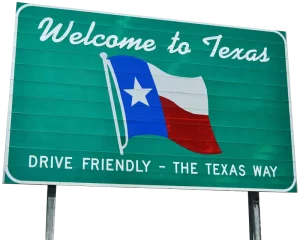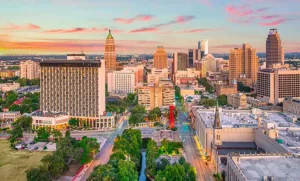Pros and Cons Of Moving to Texas in 2024
Go Back To Previous PageRelocation to Texas continues to be a popular choice for many Americans, driven by several key factors. Texas attracts people through economic incentives, educational opportunities, cultural diversity, favorable climate, and family-friendly cities. Moving to Texas, here we come!
opportunities, cultural diversity, favorable climate, and family-friendly cities. Moving to Texas, here we come!
One of the primary reasons people are moving to Texas is its robust economy, bolstered by various business-friendly economic incentives such as the Texas Enterprise Fund and Texas Enterprise Zone Program. These programs encourage job creation and capital investment, making Texas an attractive location for businesses and job seekers.
Education is another strong draw for the state, with Texas home to highly-ranked universities like the University of Texas, Southern Methodist University, and Rice University. These institutions offer excellent academic programs and research opportunities and contribute to a skilled workforce supporting the state’s economy.
The cultural diversity of Texas is also a significant factor.
Texas is known for being a melting pot of cultures, languages, and political views, which creates a prosperous and inclusive environment. This diversity is reflected in the variety of languages spoken in the state, including Spanish, Vietnamese, and Chinese, and the significant number of international migrants who choose to settle in Texas.
Texas also boasts a pleasant climate with warm weather, allowing for various outdoor activities year-round. This particularly appeals to those seeking to escape colder climates and enjoy activities like swimming, hiking, and camping throughout the year. Additionally, Texas experiences all four seasons, offering various weather conditions and recreational opportunities.
Family-friendly cities in Texas offer safe and vibrant communities with affordable housing, quality education, and ample recreational activities, making them ideal for families looking to settle down.
Relocating to a new state like Texas can be a significant undertaking, and professional movers can play a crucial role in this transition. They can provide valuable assistance with packing, transporting, and unpacking belongings, ensuring a smooth and stress-free move.
Movers familiar with the area can also offer insights and guidance about living in Texas, helping new residents quickly acclimate to their new environment. This can include information about local amenities, schools, healthcare facilities, and community events, making life in Texas more enjoyable.
Pros of Moving to Texas 2024
No State Income Tax
One of the most significant financial advantages of living in Texas is the absence of a state income tax. This policy means that residents of Texas must not pay state taxes on their income, which can lead to increased take-home earnings compared to residents in states with an income tax.
However, it’s important to note that residents are still subject to federal income taxes while there is no state income tax. The federal income tax rates and thresholds vary depending on factors like filing status and taxable income.
For instance, in 2024, a single filer in Texas falls into different federal tax brackets ranging from 10% to 37%, depending on their income level. The same applies to other filing statuses like married (filing jointly or separately), head of household, and widower.
It’s also worth mentioning that even though Texas does not levy a state income tax, it has implemented other forms of taxation to fund public services and infrastructure. For instance, Texas imposes sales and property taxes, which can be relatively high compared to other states.
This taxation system shifts the tax burden from income to consumption and property ownership. Therefore, while residents benefit from no state income tax, they might encounter higher costs in other areas, such as property or sales taxes on goods and services.
This unique tax structure in Texas is a crucial consideration for individuals and businesses contemplating a move to the state. It offers significant savings for those earning higher incomes but also requires understanding the broader tax implications, including federal and other state-specific taxes.
Booming Job Market
The job market in Texas is expected to grow in 2024, albeit at a slower pace compared to the rapid expansion seen in recent years. Factors such as high inflation, increased interest rates, and a softening U.S. and global economy are likely to moderate the overall economic growth in the state.
Despite these challenges, Texas’s economy is still set to outperform the national average, driven by its diverse economic base and the rebound in the energy industry. The state’s job market is bolstered by businesses and individuals relocating from coastal cities to Sunbelt suburbs, further stimulated by the energy sector’s revival.
As the year progresses, the economy will gain momentum, especially in the latter half of 2024, with inflation expected to slow down and the Federal Reserve potentially cutting interest rates. This optimistic outlook suggests that Texas will remain a robust environment for job growth and economic activity, attracting more inward migration and investment.
Affordable Housing
As of 2024, affordable housing in Texas presents a complex picture marked by a blend of challenges and opportunities. One significant aspect of affordable housing in the state is the Section 8 Housing Choice Voucher program, which offers rental assistance to low-income families, older people, and disabled individuals.
Eligibility for this program is determined based on income limits relative to the area’s median income and family size. For example, in 2023, the income limit for a family of four in most Texas counties was $50,750 per year.
However, these income limits can vary across different counties and metropolitan areas. Additionally, the maximum rent that Section 8 will cover depends on factors like the fair market rent (FMR) for the area and the size of the rental unit. The tenant typically pays 30% of their adjusted gross income towards rent.
The program also faces constraints such as funding limitations and waiting lists, underscoring the state’s high demand for affordable housing options.
The overall housing market in Texas also reflects evolving trends and challenges. As of late 2023, the average home value in Texas stood at $296,127, with a slight decline of 1.4% from the previous year. Median home prices experienced a month-over-month decrease, with about half of homes priced between $200,000 and $400,000.
This price range indicates a considerable segment of the housing market that could be within reach of middle-income buyers. The housing market also shows signs of dynamism, with homes moving quickly into the pending phase, typically within 29 days of listing.
Furthermore, while some areas in Texas are projected to grow in home prices, other regions are expected to face reductions, offering a varied landscape for potential buyers.
This diverse market scenario underscores the importance of location and market dynamics in the Texas housing market, which impact housing affordability and availability.
The state’s housing situation is also affected by rising homelessness, as seen in the more than 12% increase in homelessness in Texas in 2023. This uptick highlights the growing gap between housing costs and the ability of low-income households to afford them, exacerbated by the end of pandemic-era safety nets like federal rent relief funds and eviction pauses.
Despite these challenges, initiatives in major Texas cities have shown promise in reducing chronic homelessness and connecting people with housing and support services.
Rich Cultural Scene
Texas’s cultural scene in 2024 continues to be as vibrant and diverse as the state itself, offering a rich tapestry of artistic experiences across various cities. Austin, for instance, is a hub of creativity, showcasing an array of contemporary art exhibitions.
The city’s art scene features various exhibitions, from prints exploring Daoist concepts to sculptures delving into Mesoamerican dream theory. These exhibits highlight local artists’ talent and offer visitors a glimpse into the diverse cultural influences that shape Texas’s artistic landscape.
Austin’s public libraries and galleries are pivotal in promoting these diverse art forms, making the city a haven for art enthusiasts and cultural explorers.
Irving, another Texas city, also boasts a dynamic local art scene. With attractions like the Irving Arts Center, which offers a range of visual arts, theater, and dance, and the Mustangs of Las Colinas, a striking sculpture exhibit, the city caters to a wide array of artistic tastes.
Irving’s public art collection further enriches the city’s streetscape, featuring over 30 installations that add creativity to public spaces. Organizations like the Irving Black Arts Council and the Irving Art Association contribute significantly to promoting African American arts and culture and fostering artistic excellence among local artists.
The city’s symphony orchestra adds to this rich cultural mix, offering captivating and enriching symphonic arts experiences.
Austin’s support for its creative community is evident through funding for cultural attractions and public art projects. The city’s dance, theater, and visual art scenes are active throughout the year, with events like the Austin Studio Tour and Ballet East Dance Company performances.
The African American Cultural and Heritage Facility in Austin is crucial in celebrating African American heritage and history. Public artworks in Austin, such as murals and sculptures, reflect the city’s commitment to artistic expression and cultural diversity, making it an exciting destination for those seeking to immerse themselves in a culturally rich environment.
Favorable Climate
According to the Climate Prediction Center (CPC), the climate in Texas for the winter of 2023-2024 is expected to be characterized by wetter-than-average conditions. This is primarily attributed to the El Niño phenomenon, which typically brings wetter conditions across the southern United States, including Texas.
The presence of El Niño has been confirmed by the end of October, meeting the criteria for an official El Niño period. This is expected to hold through the winter months, offering potential relief to the state’s hydrologic cycle, which strained long-standing drought conditions.
However, it’s important to note that while wetter conditions are anticipated, extreme winter weather with frozen precipitation is not likely in Texas for this period. The CPC does not forecast a colder-than-normal season but predicts near-normal average temperatures through February.
This implies that, even in the coldest areas of North Texas, average temperatures are not expected to dip down to freezing but rather maintain highs in the upper 50s and lows in the upper 30s. As a result, frozen precipitation is not a favored prediction for this time. However, staying updated with the latest forecasts is essential, as weather conditions can change, and being prepared for any potential shifts is crucial.
Overall, Texas’s winter climate for 2023-2024 is shaping to be wetter but not significantly colder than usual, a trend that might help alleviate some of the drought-related concerns while not leaning toward extreme freezing weather events.
Cons of Moving to Texas 2024
High Property Taxes
Texas is known for having some of the highest property taxes in the United States. To address this, a significant property tax relief bill was passed in Texas, providing around $18 billion in reductions for homeowners. This new law, which went into effect on January 1, 2024, aims to alleviate the property tax burden on Texas homeowners.
The key feature of this bill is the increase in the homestead exemption, which was raised from $40,000 to $100,000 per year. This means that homeowners can deduct a more significant amount from the value of their primary residence before taxes are calculated. The bill also includes an appraisal cap on residential and commercial properties and a reduction in the school district’s maintenance and operations property tax rate.
While this tax relief is significant for homeowners, it has sparked controversy because it does not directly benefit tenants burdened with high living costs. As renters make up a substantial portion of the population in major Texas cities, there are concerns that they will not see any direct benefits from this tax relief.
Proponents of the relief, however, argue that market forces might result in some benefits trickling down to renters, particularly in markets with a surplus of vacancies. However, this outcome is not guaranteed, and as of now, renters are not receiving direct tax relief under this new law. This situation highlights the ongoing debate about the equitable distribution of tax relief among different groups within the state.
Traffic and Transportation Challenges
Texas is addressing its traffic and transportation challenges with a significant investment in infrastructure development. In collaboration with the Texas Department of Transportation (TxDOT), Governor Greg Abbott has announced a record 10-year transportation plan amounting to $100 billion.
This ambitious plan caters to the increasing population and the subsequent demand for improved and expanded transportation infrastructure. Its primary focus is to enhance congestion management, maintain roadways effectively, and elevate safety standards across the state.
Such a large-scale investment indicates Texas’s commitment to addressing the growing traffic and transportation challenges that concern residents and businesses alike.
TxDOT is actively seeking public input on the draft 2024 Unified Transportation Program (UTP), which is the state’s 10-year transportation plan. The draft UTP, totaling $100 billion, is $15 billion more than the 2023 plan.
This increase is primarily due to revenue growth from Proposition 1, passed in the 2015 legislative session, generated by oil and gas severance fees dedicated to highway improvements. The projects included in the UTP aim to improve safety, address congestion, and connectivity, and preserve roadways for Texas drivers.
Additionally, the UTP covers various aspects of transportation, including public transportation, maritime transportation, aviation, rail transportation, freight transportation, international trade, and bicycle and pedestrian connectivity.
Extreme Weather Conditions
In early 2024, Texas experienced extreme weather conditions, affecting various parts of the state. For instance, blizzard warnings were issued in the far southwestern Texas Panhandle due to heavy winds and snow, leading to “whiteout” conditions.
These severe weather conditions caused significant traffic delays and road closures. Additionally, Houston began the year with tornado warnings, and the first tornado was reported to have touched the ground for 200 yards.
A few days later, further tornado warnings were issued in the region, with at least one tornado spotted near West Livingston and Indian Springs. Alongside these challenges, the San Antonio area faced increased fire risks due to windy conditions and low humidity, prompting the National Weather Service to issue fire danger statuses and red flag warnings for critical fire weather conditions.
To address these challenges, the Texas Department of Emergency Management (TDEM) has been actively providing resources and information to help Texans prepare for and respond to these extreme weather events. TDEM’s initiatives include a focus on extreme cold air expected to affect the entire state, with temperatures dropping to the 10s in some areas and wind chills below zero anticipated across much of the state’s northern half.
This comprehensive approach by TDEM aims to ensure the safety and preparedness of residents, providing valuable resources for individual and family preparedness and support for local officials and emergency managers.
Education System Concerns
As of 2024, the Texas education system is facing several significant challenges. One primary concern is the teacher shortage, a critical issue for state lawmakers and public education advocates.
A poll released by the Charles Butt Foundation found that 77% of Texas teachers seriously considered leaving the profession, up from 58% in 2020. After the 2021-2022 school year, there was a notable increase in teacher resignations, with 42,839 teachers leaving their jobs compared to 33,949 the previous year. Economic factors, such as lagging salaries and stagnant pensions, have been cited as primary reasons for this departure.
The Texas State Teachers Association highlighted that many teachers struggle financially due to low pay and inadequate retirement benefits.
Another aspect contributing to the educational challenges in Texas is the school funding system. Despite the state experiencing a significant budget surplus, the funding for public schools has not been adequately addressed since 2019. Texas ranks in the bottom 10 to 12 states for education spending per student.
The current funding system is based on attendance rather than enrollment, disproportionally affecting districts with higher poverty levels and those with a higher percentage of special education students.
This system also fails to automatically allocate more funds to schools when property values and taxes rise, leading to public mistrust and misunderstanding about school funding. Efforts to shift to an enrollment-based funding system have been proposed but have not yet gained sufficient legislative support.
Healthcare Accessibility and Costs
Healthcare in Texas is facing significant challenges, particularly regarding accessibility and affordability. In 2020, Texas’s per capita healthcare spending was $9,822, ranking the state 48th in the nation for healthcare spending per person. This figure indicates a significant investment in healthcare, but it doesn’t directly translate into widespread access or affordability for all residents.
The state struggles with a high rate of uninsured residents. In 2021, 17.97% of Texans, the highest share of the uninsured population in the United States, were not covered by health insurance. This lack of insurance is particularly problematic given the state’s high healthcare costs.
Texas did not expand Medicaid under the Affordable Care Act and has relatively strict adult Medicaid eligibility criteria compared to other states, contributing to this situation.
Moreover, a report from PwC predicts a 7% increase in healthcare costs for health plans in 2024, higher than the previous two years. This increase is attributed to inflation, workforce shortage, and rising drug costs. Despite this, there is hope that shifts in care settings and introducing biosimilar drugs might help mitigate some of these cost increases.
The situation is particularly dire for specific demographic groups.
Lower-income residents, Hispanic Texans, and those in poorer health are more likely to report difficulties in affording healthcare.
For example, Texans with family incomes under 250% of the federal poverty level are almost twice as likely as those with higher incomes to report difficulties in affording healthcare. Similarly, Hispanic residents report more difficulty affording healthcare compared to their Black and white counterparts.
According to The Commonwealth Fund, Texas’s healthcare system also lacks access and affordability, ranking last in the U.S. The state’s decision not to expand Medicaid eligibility significantly contributes to this poor ranking.
The lack of insurance disproportionately impacts minorities in Texas, with a higher percentage of African American and Hispanic adults being uninsured compared to the national average.
The need for healthcare reform in Texas is apparent. A poll found that healthcare costs are a top priority for many state residents, yet there seems to be a lack of legislative motivation to address these issues. This lack of action has severe consequences, especially for the economically vulnerable population participating in Medicare and Medicaid.
Texas ranks 28th in spending for dual-eligible enrollees, indicating a significant financial burden on those who rely on Medicare and Medicaid.


